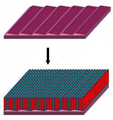


Berkeley Lab interim-director Paul Alivisatos, speaking at the AAAS annual meeting in Chicago, called for a “science-to-solutions” approach to energy, in which basic scientific research is integrated into scaled-up applied technology development. The national laboratories can serve as “anchor points” in this effort, working closely with universities and private companies to provide an institutional setting where basic and applied research interactions can take place in a timely way. In his talk, he also touted the potential of nanocrystal solar cells as a prime area of focus for this science-to-solutions approach. More>
 After analyzing records from a decade’s worth of solar power installations, EETD researchers Ryan Wiser, Galen Barbose, and Carla Peterman conclude that overall costs have declined significantly because of decreases in associated expenses such as labor and overhead – most likely because of federal, state, and local support for solar photovoltaic systems. More>
After analyzing records from a decade’s worth of solar power installations, EETD researchers Ryan Wiser, Galen Barbose, and Carla Peterman conclude that overall costs have declined significantly because of decreases in associated expenses such as labor and overhead – most likely because of federal, state, and local support for solar photovoltaic systems. More>
 An innovative and easily implemented technique in which nanoscale elements precisely assemble themselves over large surfaces could soon open doors to dramatic improvements in the data storage capacity of electronic media, according to scientists at the UC Berkeley and UMass Amherst. Berkeley Lab materials scientist Ting Xu was the co-lead investigator of the study. More> A story on this research also appeared in Forbes magazine.
An innovative and easily implemented technique in which nanoscale elements precisely assemble themselves over large surfaces could soon open doors to dramatic improvements in the data storage capacity of electronic media, according to scientists at the UC Berkeley and UMass Amherst. Berkeley Lab materials scientist Ting Xu was the co-lead investigator of the study. More> A story on this research also appeared in Forbes magazine.
 In The News: Single Carbon Nanotube Functions as Tiny Radio
In The News: Single Carbon Nanotube Functions as Tiny Radio[Scientific American] Who would have expected that one of the first truly functional nanoscale devices — one that would have a measurable effect on the larger, macroscale world — would prove to be ... a radio? But the nanotube radio, invented by Berkeley Lab materials scientist Alex Zettl, performs a set of amazing feats: a single carbon nanotube tunes in a broadcast signal, amplifies it, converts it to an audio signal and then sends it to an external speaker in a form that the human ear can readily recognize. More>
 Hoping to emulate the influence of the report “The Landscape of Parallel Computing Research: A View From Berkeley” from UC Berkeley’s Parallel Computing Laboratory (Par Lab), a group of a dozen faculty and grad students spent six months brainstorming about the impact and future directions of cloud computing. David Patterson, who has a joint appointment in Berkeley Lab’s Computational Research Division, was one of the leaders of both projects. The resulting report, “Above the Clouds: A Berkeley View of Cloud Computing,” has just been made available. Lab contributors include Krste Asanovic, John Shalf, Samuel Webb Williams, and Kathy Yelick. More>
Hoping to emulate the influence of the report “The Landscape of Parallel Computing Research: A View From Berkeley” from UC Berkeley’s Parallel Computing Laboratory (Par Lab), a group of a dozen faculty and grad students spent six months brainstorming about the impact and future directions of cloud computing. David Patterson, who has a joint appointment in Berkeley Lab’s Computational Research Division, was one of the leaders of both projects. The resulting report, “Above the Clouds: A Berkeley View of Cloud Computing,” has just been made available. Lab contributors include Krste Asanovic, John Shalf, Samuel Webb Williams, and Kathy Yelick. More>
 In The News: IT Industry Groups Seek LEED for Datacenters
In The News: IT Industry Groups Seek LEED for Datacenters[Greener Computing] With help from Berkeley Lab, a coalition of groups is asking the U.S. Green Building Council for LEED certification standards for datacenters. A draft of LEED for datacenters has been developed, submitted to the USGBC for consideration. The project to develop the criteria was led by Ray Pfiefer of the Silicon Valley Leadership Group and William Tschudi, with Berkeley Lab’s Environmental Energy Technologies Division. More>
Fidelity Retirement Services is in the process of mailing out the 2009 Retirement Update and Readiness Guide to all UCRP members who were active as of Dec. 31, 2008, and who received covered pay in October 2008. This mailing will include a personalized Retirement Update. More>